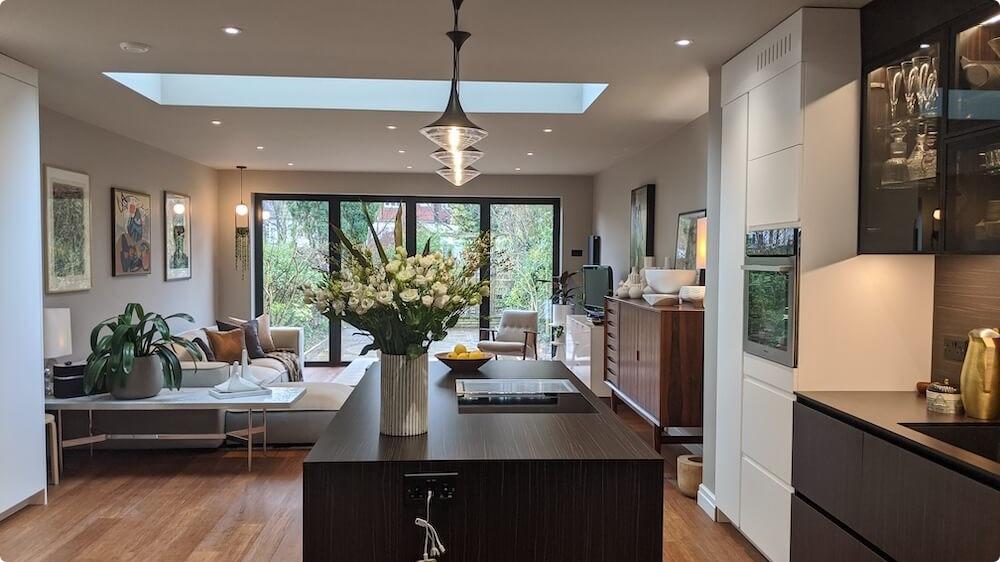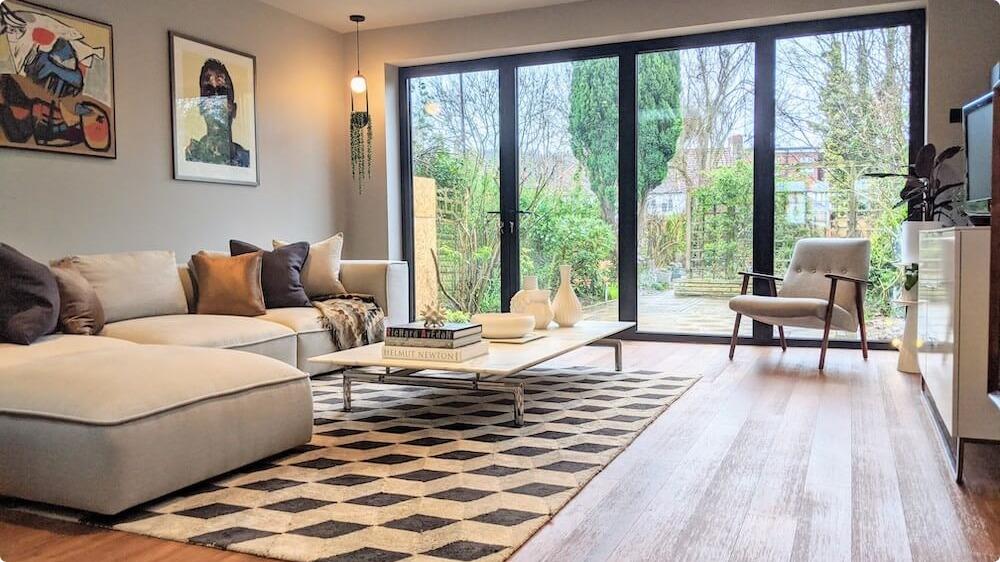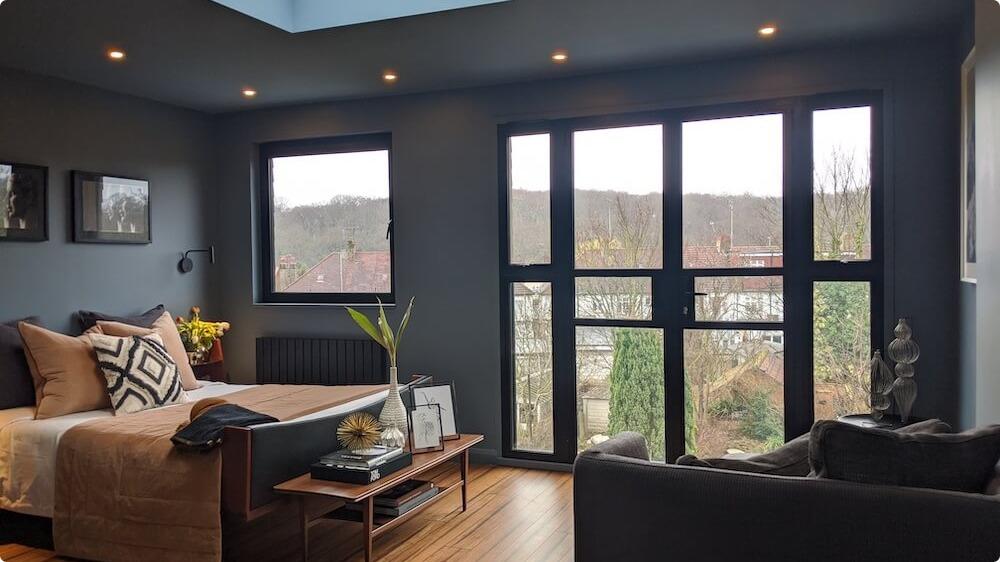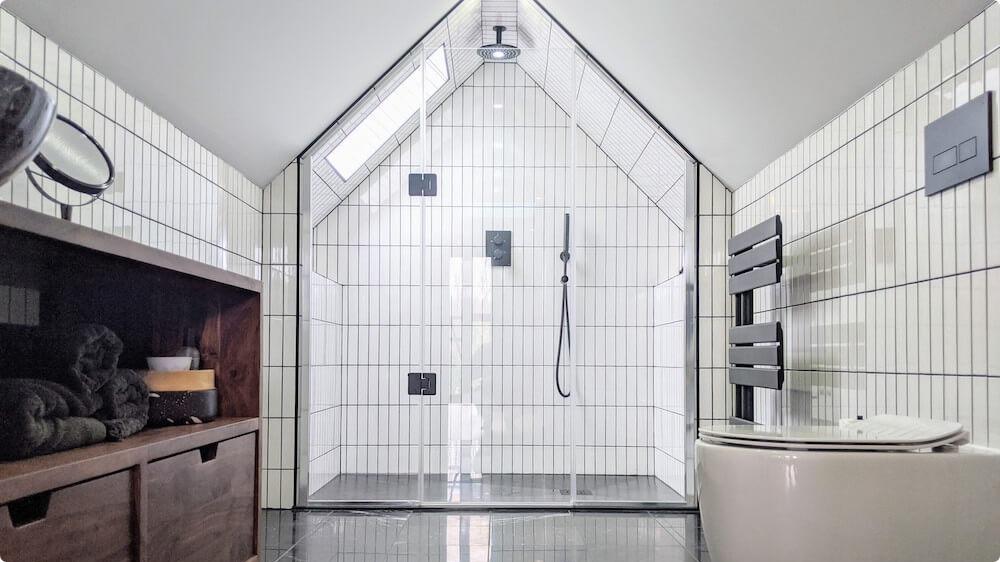Although terraced houses are common in the UK, they tend to get a bad reputation, with many assuming they offer little in the way of space and style.
Whatever your opinion on them, a terraced house extension presents you with an opportunity to add more space to your home while giving it a contemporary facelift.
If you're looking to expand your terraced home then you're in the right place. This article covers:
- Benefits of a terrace house extension
- Ideas for a terraced house extension
- Planning Permission for your extension
Wondering about cost? Get your free Resi quote here.
What is a terraced house extension?
Terraced houses, otherwise known as 'row homes', are rows of similar houses joined together by their sidewalls.
They can be pretty small and are infamous for their darker interior.
A terraced house extension, however, gives you the option to convert your minimal living space into a larger area and, with the right design, incorporate more natural light as well.
What are the benefits of a terraced house extension?
Terraced house extensions provide a lot of benefits, some of which are:
- More space -Adding an extension to your terrace house is a great way to increase your living space to accommodate your family's growing needs without moving house
- More light -House extensions are a great way to incorporate more natural light into your home
- Add Value -Adding an extension to your home can increase the value of your home
Ideas of terraced house extensions
If you've been wondering how you can extend your terrace home, here are some ideas to get your creative juices flowing.
Single storey extensions
There are a number of ways you could add a single storey extension to your terraced building. You can decide to:
Add a rear extension into the garden for a bigger kitchen
If you have a decent-sized garden, carrying out a ground floor rear extension is an excellent option. Terraced houses are often characterised by their small layouts and are primarily known for narrow kitchen areas, usually tucked away at the rear of the house. The most popular way to get a bigger kitchen is to create a ground floor rear extension.
You can extend up to 3 meters under permitted development or up to 6 meters, provided you undergo prior approval.
Add a new dining area
Adding a rear extension to a terrace property is a great way to add that dining room you've been longing for. There are plenty of dining options to choose from, so make sure you opt for a dining space that suits your family. Many people like the idea of a separate dining room, but informal breakfast bars sometimes suit busy households better.
Add a bigger entrance hall
Most terraced houses do not have an entrance hall, and even when they do, they tend to be relatively small. Adding an extension would enable you to add a tailored and stylish entrance hall, rather than opening your front door right into your living spaces. When it comes to selling, this added feature may help increase the desirability of your home.
Install a WC and bathroom downstairs
Many home buyers expect to find a WC downstairs, as they’re not only more accessible but also stop guests from traipsing upstairs to more private areas. When adding a WC downstairs, you must remember that the minimum practical space around standard sanitary ware in a WC is 200mm on each side and 600mm in front.
Add more bedrooms
Adding an extra bedroom provides one of the best opportunities for increasing the value of your home. Zoopla once estimated that a new bedroom could add up to 21% of extra value - nothing to be sniffed at! With a terraced house extension, you could either opt for a two-storey addition, or extend your ground-floor and situate a new bedroom here. However, bear in mind that ground floor bedrooms are deemed less desirable than their upstairs counterparts.
Two storey extension
Adding a two storey extension to your terraced house might not seem cost-effective, considering how big of a project it is, but you’ll actually find the cost per square metre to be lower for these kinds of builds due to the huge amount of space they generate. What’s more, with a two storey extension, you get double the living area for the same amount of garden space as a rear extension.
With two storey extensions in a terraced property, you need to be aware of the 45-degree rule, to ensure you're not blocking too much light from your neighbours.
You should discuss your project with a Resi expert for more information on the 45-degree rule and how it applies to your two-storey extension.
Basement conversion
Many old homes were built with cellars that can be converted. However, converting your basement depends on various factors, such as the existing condition of the area and whether or not you want to retrofit extra space on top of your conversion. Before converting your basement, you should weigh the cost of the conversion against the value it will add to your home to confirm it's a profitable venture.

Loft extensions
If you've some extra space in your attic then you seriously should consider a loft extension. Not only will a loft extension add floor space to your home, it's also a clever way of adding value to your property. Loft extensions are perfect for growing families and can be used as a guest bedroom, a study, a playroom or lounge.
Depending on your budget and what you have in mind, you can opt for a dormer loft extension, a hip to gable loft extension, a mansard loft extension or a rooflight loft extension.
Get a design quote for your terraced house extension here.
A loft conversion and rear extension in Greenwich
This dated Victorian terrace house was modernised by the addition of a side extension, which helped to create an open-plan kitchen, diner, and living space - complete with storage for bulky appliances. Alongside this ground floor addition, we also used a loft conversion to create a stunning master bedroom, with a white tiled en-suite and juliet balcony.




How much does a terraced house extension cost?
It's difficult to state directly how much a terraced house extension would cost as many factors determine this value.
For one thing, the type of extension you go for will significantly affect the cost of extending your home. Other factors worth considering include:
- Location of your home
- Finishing and fixtures
- Building material
- Size of the extension
A rear extension on terraced house can cost roughly £1,200 to £3,300 per square meter, with the higher spectrum applicable to homes in London.
Visit our cost calculator for a detailed estimate of how much your terraced house extension will cost.
How much value will an extension add to my terraced house?
Adding a terrace to your extension could increaseyour property’s value by as much as 20%. However, this will be dependent on several key factors…
- Your location
- Ceiling prices in your area
- Quality of the work
- Type of extension
- Whether a new bedroom has been added
- The state of the property market
Want to discuss finance routes and potential property equity increases? Time to explore Resi Finance.
What are the important factors to consider when designing a terraced house extension?
Listed here are some important factors to consider when designing your terraced house extension.
Lighting
When designing a terraced house extension, consider incorporating more natural light into your home. You can achieve this by adding a skylight or sky tunnel to your roof, installing internal glass doors, opting for an open plan, or turning external windows into doors.
Overlooking neighbours
When adding your extension, you must ensure no part of your extension overlooks your neighbours. You can mitigate this by either clever design, provided by an experienced architect, or opting for frosted glass in key areas.
Overshadowing Neighbours
Constructing a two storey extension that extends too far out the back (from your house to the garden) may overshadow the neighbours. This too can limit how big you can build the extension. As with most technical issues, it best to discuss your options with an architect.
Book a free architectural consultation here with Resi’s experts.
How much can you extend a terraced house?
A terraced house single storey extension can stretch as far back as 3m under permitted development and 6m with prior approval. Anything more than this and you'll need to apply for planning permission.
Do I need to consider planning permission when extending a terraced house?
You will not usually need to apply with a full planning application for a terraced house extension if:
- It is not closer to the highway than any part of the house
- It takes up at most 50% of the land area around the original house
- It won't be higher than 4m within 2m of the property boundary and no more than 6 or 3 metres deep for a single or double storey extension
- The house is not in a conservation area
What other permissions do I need to consider?
Here are a few other permissions to consider when planning an extension.
Permitted development
Permitted development can be strict in terms of design and size. To ensure your project is within your permitted development rights, you should employ the services of an architect, who can help you secure a lawful development certificate - proving to future buyers your build was legal.
Party wall agreement
If you are extending a terraced house, you'll need handle any relevant party wall matters. The first step will be to service your neighbour(s) with a party wall notice. If they fail to give written consent, you'll need to hire one or more surveyors to get a party wall agreement in place.
Right of light
Your neighbours are entitled to an amount of light, which must be seriously considered when building an extension.
Many homeowners choose glazed extensions to help with the right of light issue. This way, their extension allows light to flow through into the neighbouring property.
Building regulations
For your home to be deemed habitable, it must adhere to building regulations concerning ventilation, fire safety, heating, and the likes. These regulations ensure that your home doesn't pose any harm to you or the surrounding environment.
Learn more about Resi's comprehensive building regulations package.
Can my neighbours complain?
Upon your application for planning permission, letters will be sent to your neighbours for their consent. However, their approval or disapproval does not determine if you are given permission.
You should also bear in mind that prior approval allows your neighbours to complain if your extension infringes on their privacy or affects their right of view.
Still, we recommend you speak to a Resi expert to ensure that your project is compliant.
Mistakes to avoid
Here are some mistakes to avoid when extending your terrace house.
Not considering access
It's imperative you consider access when adding an extension to your home. Homes without access will leave the builders with no other choice but to carry the materials through the house while the extension is under construction. Settling access earlier will avoid dusty inconvenience.
Gloomy interiors
As terraced houses are extended to the back, the middle rooms of the house are often cut off from natural sources of light, making them dark and gloomy. To avoid this, ensure you have as much light on the rear wall as possible.
Failure to consider all the costs involved
Budgeting for an extension can be pretty daunting, and a terraced extension is no different. To avoid any nasty surprises during your renovation journey, it helps to get a breakdown of all the costs you’ll likely encounter from the start, as well as giving yourself a 10% contingency fund. Things rarely run as smoothly as we would like, and on a construction site, unforeseen costs can pop up out of nowhere, either from bad weather to shipping delays. Having a contingency fund at the start will prevent you from having to scramble for extra cash at the most important moment of your project.
If you'd like to extend your terraced home but aren't sure how to go about it, you can start with booking a free consultation with our experts.


























